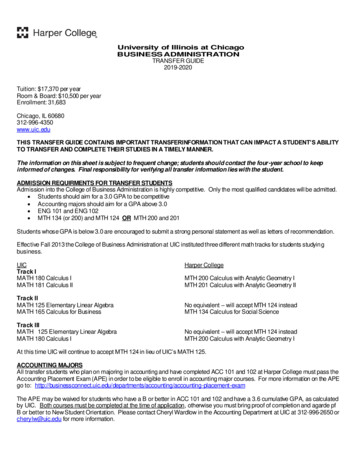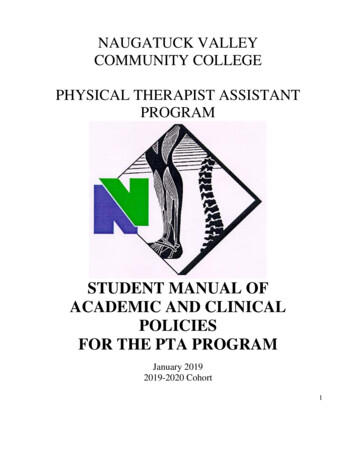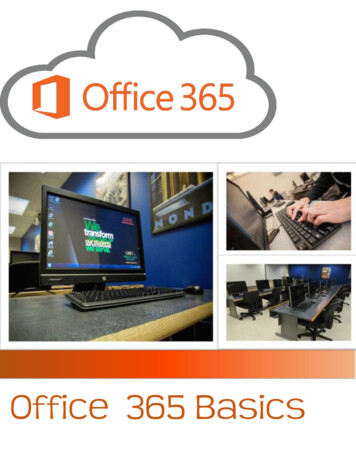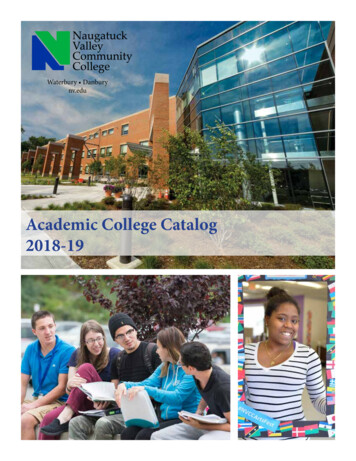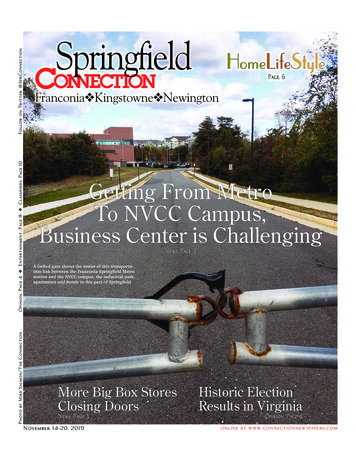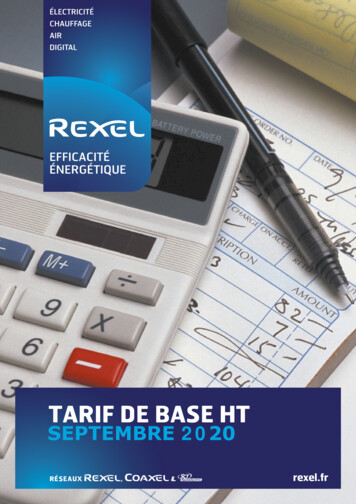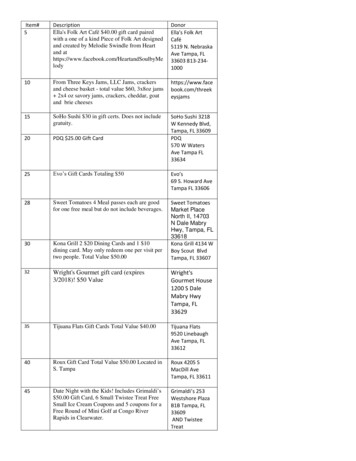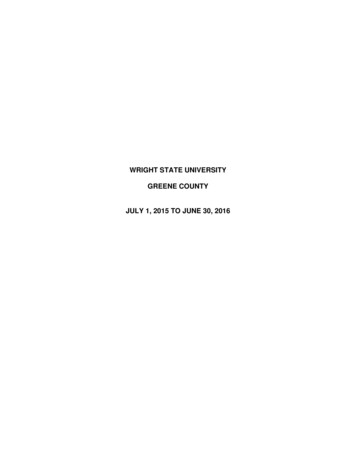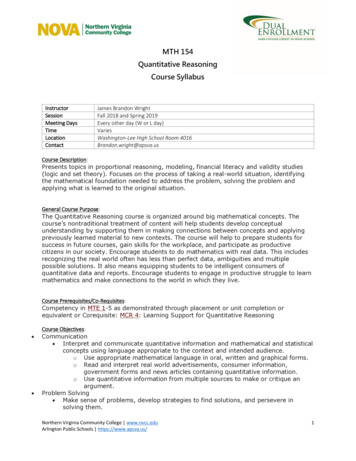
Transcription
MTH 154Quantitative ReasoningCourse SyllabusInstructorSessionMeeting DaysTimeLocationContactJames Brandon WrightFall 2018 and Spring 2019Every other day (W or L day)VariesWashington-Lee High School Room 4016Brandon.wright@apsva.usCourse Description:Presents topics in proportional reasoning, modeling, financial literacy and validity studies(logic and set theory). Focuses on the process of taking a real-world situation, identifyingthe mathematical foundation needed to address the problem, solving the problem andapplying what is learned to the original situation.General Course Purpose:The Quantitative Reasoning course is organized around big mathematical concepts. Thecourse’s nontraditional treatment of content will help students develop conceptualunderstanding by supporting them in making connections between concepts and applyingpreviously learned material to new contexts. The course will help to prepare students forsuccess in future courses, gain skills for the workplace, and participate as productivecitizens in our society. Encourage students to do mathematics with real data. This includesrecognizing the real world often has less than perfect data, ambiguities and multiplepossible solutions. It also means equipping students to be intelligent consumers ofquantitative data and reports. Encourage students to engage in productive struggle to learnmathematics and make connections to the world in which they live.Course Prerequisites/Co-Requisites:Competency in MTE 1-5 as demonstrated through placement or unit completion orequivalent or Corequisite: MCR 4: Learning Support for Quantitative Reasoning Course Objectives:Communication Interpret and communicate quantitative information and mathematical and statisticalconcepts using language appropriate to the context and intended audience.o Use appropriate mathematical language in oral, written and graphical forms.o Read and interpret real world advertisements, consumer information,government forms and news articles containing quantitative information.o Use quantitative information from multiple sources to make or critique anargument.Problem Solving Make sense of problems, develop strategies to find solutions, and persevere insolving them.Northern Virginia Community College www.nvcc.eduArlington Public Schools https://www.apsva.us/1
MTH 154Quantitative ReasoningCourse Syllabusoo Develop an answer to an open-ended question requiring analysis andsynthesis of multiple calculations, data summaries, and/or models.Develop personal problem solving processes and apply them to applicationsstudied over an extended period of time.Reasoning Reason, model, and draw conclusions or make decisions with quantitativeinformation.o Draw conclusions or make decisions in quantitatively based situations that aredependent upon multiple factors. Students will analyze how differentsituations would affect the decisions.o Present written or verbal justifications of decisions that include appropriatediscussion of the mathematics involved.o Recognize when additional information is needed or the appropriate times tosimplify a problem.Evaluation Critique and evaluate quantitative arguments that utilize mathematical, statistical,and quantitative information.o Evaluate the validity and possible biases in arguments presented in real worldcontexts based on multiple sources of quantitative information - for example;advertising, internet postings, consumer information, political arguments.Technology Use appropriate technology in a given context.o Use a spreadsheet to organize quantitative information and make repeatedcalculations using simple formulas.o Explore internet-based tools appropriate for a given context - for example, anonline tool to calculate credit card interest or a scheduling software package.Financial Literacy Simple Interesto Define interest and understand related terminology.o Develop simple interest formula.o Use simple interest formulas to analyze financial issues Compound Interesto Describe how compound interest differs from simple interest.o Explain the mechanics of the compound interest formula addressing itemssuch as why the exponent and (1 r/n) is used.o Use compound interest formulas to analyze financial issueso Show the difference between compound interest and simple interest using atable or graph. Borrowingo Compute payments and charges associated with loans.o Identify the true cost of a loan by computing APRo Evaluate the costs of buying items on credito Compare loans of varying lengths and interest rates. InvestingNorthern Virginia Community College www.nvcc.eduArlington Public Schools https://www.apsva.us/2
MTH 154Quantitative ReasoningCourse SyllabusCalculate the future value of an investment and analyze future value andpresent value of annuities (Take into consideration possible changes in rate,time, and money.)o Calculate profit from a sale of an investmento Compare various investment options and understand when it is appropriateutilize themPerspective Matters - Number, Ratio, and Proportional Reasoning Solve real-life problems requiring interpretation and comparison of complex numericsummaries which extend beyond simple measures of center. Solve real-life problems requiring interpretation and comparison of variousrepresentations of ratios (i.e., fractions, decimals, rates, and percentages). Distinguish between proportional and non-proportional situations and, whenappropriate, apply proportional reasoning. Recognize when proportional techniquesdo not apply. Solve real-life problems requiring conversion of units using dimensional analysis. Apply scale factors to perform indirect measurements (e.g., maps, blueprints,concentrations, dosages, and densities). Order real-life data written in scientific notation. The data should include differentsignificant digits and different magnitudes.Modeling Observationo Through an examination of examples, develop an ability to study physicalsystems in the real world by using abstract mathematical equations orcomputer programso Make measurements of physical systems and relate them to the input valuesfor functions or programs. Examples: measure distance and time for a toycar, length of candle and time as it burns, length of vertical spring underdifferent weights attached (linear); temperature and time for a refrigeratedliquid as it warms (nonlinear)o Compare the predictions of a mathematical model with actual measurementsobtainedo Quantitatively compare linear and exponential growtho Explore the mathematical and logical structures that enable familiar modelsencountered in daily life: Weather models, Financial models, Simple physicalmodels, Normal and Exponential Population Models. Mathematical Modeling and Analysiso Assemble measurements and data gathered (possibly through surveys,internet, etc.) into tables, displays, charts, and simple graphs.o Explore interpolation and extrapolation of linear and non-linear data.Determine the appropriateness of interpolation and/or extrapolation.o Identify and distinguish linear and non-linear data sets arrayed in graphs.Identifying when a linear or non-linear model or trend is reasonable for givendata or context.o Correctly associate a linear equation in two variables with its graph on anumerically accurate set of axeso Northern Virginia Community College www.nvcc.eduArlington Public Schools https://www.apsva.us/3
MTH 154Quantitative ReasoningCourse SyllabusNumerically distinguish which one of a set of linear equations is modeled by agiven set of (x,y) data pointso Identify a mathematical model's boundary values and limitations (and relatedvalues and regions where the model is undefined). Identify this as the domainof an algebraic model.o Using measurements (or other data) gathered, and a computer program(spreadsheet or GDC) to create different regressions (linear and non-linear),determine the best model, and use the model to estimate future values. Applicationo Starting with a verbally described requirement, generate an appropriatemathematical approach to creating a useful mathematical model for analysiso Explore the graphical solutions to systems of simultaneous linear equations,and their real world applicationso Numerically analyze and mathematically critique the utility of specificmathematical models: instructor-provided, classmate generated, and selfgeneratedValidity Studies Identify logical fallacies in popular culture: political speeches, advertisements, andother attempts to persuade Relate the concept of a "statement" to the notion of Truth Value. Identify statementsand non-statements Describe the differences between verbal expression of truth and mathematicalexpression of truth. Discuss the usefulness of symbolic representation of statements.Discuss the 2-valued nature of mathematical truth value, relate this to real worldexamples. Determine the logical equivalence between two different verbal statements (simpleand compound) in real-world context. Relate the language of conditionals to the language of quantified statements Explore the relationship between quantified statements and conditional statements(e.g., "all scientists are educated" is equivalent to "if she is a scientist then she iseducated.") Apply concepts of symbolic logic and set theory to examine compound statementsand apply that to decision making of real-world applications.o Major Topics to be Included:Financial Literacy (Interest, Borrowing, and Investing)Perspective (Complex Numeric Summaries, Ratios, Proportions, Conversions, Scaling,Scientific Notation)Modeling (Observation, Mathematical Modeling and Analysis, Application)Validity Studies (Statements, Conclusions, Validity, Bias, Logic, Set Theory)Northern Virginia Community College www.nvcc.eduArlington Public Schools https://www.apsva.us/4
MTH 154Quantitative ReasoningCourse SyllabusRequired Instructional Materials: MyMathLab for Thinking Quantitatively package (ISBN: 9781323905494). Course ID for MyMathLab: Access to this MyMathLab course must occur through Blackboard.(instructorname#####) Calculator: A scientific calculator is highly recommended; a graphing calculator is optional. Regular access to a computer with a working internet connection and Microsoft Excel: If you don’t own acomputer or your computer isn’t working, you will need to do your required online work on campus.Course Credit:3 credit hours and 1 high school credit for completion of the course.Policies:Grading PoliciesI.a. Grading ScaleA 100 - 90 B 89 - 80 C 79 - 70 D 69 - 60 F 59 and belowb. In cases where district grading polices conflict with college grading policies, the high school andcollege grades may differ; this may include assignment/test retakes, extended assignment due dates,capped minimum grade allowed, among other such district policies.c. It is important that students check their final NOVA grades in Blackboard as soon as the course(s)completed.Grade Breakdown:Tests/QuizzesHomework/ClassworkExcel FilesProjectsMidterm/Final30%10%15%25%20%Arlington Grading Scale:90-100 A70-7687-89 B 67-6980-86 B60-6677-79 C 0-59CD DEThe Midterm will occur in late December or early January. The Final Exam will occur before senior experience.There are NO EXEMPTIONS for the Final.In order to simulate the experience of a college-level semester course, grades for MTH 154 will carry over all thequarters. This means that grades earned in the 1st quarter will be seen through all the quarters of the year. Nogrades will be counted twice, but a student will be able to see a running record of his/her grades throughout theentire semester.All assessments may contain any previously taught material. Student grades reflect student achievement and notstudent behaviorNorthern Virginia Community College www.nvcc.eduArlington Public Schools https://www.apsva.us/5
MTH 154Quantitative ReasoningCourse SyllabusHomework:You will have three things to complete on a consistent basis outside of class time.1. Section organizer – where you read the upcoming section filling in key terms, questions, and Excelinformation.2. MyMathLab Homework – This is homework can be accessed online.3. Excel File – You will complete the indicated Excel sheet and write a reflection about something youlearned or your thoughts about the information in the sheet.The section organizers will be checked randomly throughout the year for completion.MyMathLab homework will be graded automatically after you submit your questions. Some homework may allowa retry option until the turn-in deadline.Excel files will be submitted through Canvas. All Files should be named in the format “LastName – chapter.section”(Example Wright – 1.1)Tests:For the most part, we will have chapter tests. I will announce the date of the test at least a week in advance. If youknow ahead of time that you are going to be absent, for any excused reason, you must tell me before the day of thetest to schedule a time to take the test BEFORE it is given in class. If you neglect to do so, you will not be given theopportunity to retake the test. Please avoid making doctor's appointments during our class times.You will be asked to make up any previously scheduled missed test within one week of the last day of your absence.You must take the responsibility to schedule a make-up time. Credit will not be given if you have an unverifiedabsence on the day of a test or quiz.Projects: Will be given throughout the year.II.Course Policiesa. Academic Integrityi. The College does not tolerate academic dishonesty. Students who are not honest in theiracademic work will face disciplinary action along with any grade penalty the instructor imposes.Procedures for disciplinary measures and appeals are outlined in the Student Handbook(http://www.nvcc.edu/students/handbook/). In extreme cases, academic dishonesty may result indismissal from the College.ii. Plagiarism: is the act of appropriating passages from the work of another individual, either wordfor word or in substance, and representing them as one’s own work. This includes any submissionof written work other than one’s own. In short, plagiarism means using the exact words, opinions,or factual information from another person without giving that person credit. Students who arenot honest in their academic work will face disciplinary action along with any grade penalty theinstructor imposes. For more information about student academic /integrity.htmliii. Students are both part of Arlington Public Schools (APS) and NVCC, and they are accountable forboth academic honor codes:a. APS (page 8-9 of Washington-Lee High School student handbook)Northern Virginia Community College www.nvcc.eduArlington Public Schools https://www.apsva.us/6
MTH 154Quantitative ReasoningCourse SyllabusThere is one fundamental principle: all work submitted must be the student's own. Forhomework and class work, students may ask for assistance from other classmates or faculty,but each student's work should be unique. During exams, help is not to be given or accepted.Using another student's work or answers, and claiming them as your own is a violation.Violations will result in an automatic zero on the assignment or exam. In addition, parentsand the administration will be contacted.b.c.d.Attendance Policy for Make-up Work1.Tests/quizzes: You will be asked to make up any previously scheduled missed test or quiz withinone week of the last day of your absence. You must take the responsibility to schedule a make-uptime. Credit will not be given if you have an unverified absence on the day of a test or quiz.2.Homework: Will be due on the day on which the student returns to school from an excusedabsence. No credit will be given for homework assignments missed due to an unverified absence.Students will be able to turn in four homework assignments late each quarter for full credit, butthe assignments must be submitted before the unit test.3.Projects: Will be due on the day on which the student returns to school. A project will beconsidered late if a student has an unverified absence on the day it is due.4.The teacher and student will determine a calendar for make-up work that results from anextended absence.5.Getting notes and worksheets from the day of an absence is the responsibility of the student.Visit Mr. Wright’s website for any posted notes.Disabilitiesi. Students with disabilities are required to contact NOVA’s Office of Disability Support Services(DSS) to discuss possible accommodations. All information is kept confidential and may increaseyour chances of success in the academic setting. If accommodations are agreed upon, student willreceive a Memorandum of Accommodation (MOA) by DSS. For more information about NOVA’sDSS office: cacyi. Students are expected to reach out to their instructor if they do not understand content orexpectations.ii. College instructors and other college personnel will not talk with a parent without the permissionof and presence of the student. The conversation is between the administrator / faculty memberand the student. The parent’s role is to listen, give moral support, and summarize information andagreements if needed.iii. Dual enrolled students have access to full NOVA campus services to include tutoring, library, andcounseling services; student resources are found here: http://www.nvcc.edu/students/index.htmlNorthern Virginia Community College www.nvcc.eduArlington Public Schools https://www.apsva.us/7
MTH 154Quantitative ReasoningCourse SyllabusIII.Additional Course InformationDE students are expected to engage in college level course contents and discussions appropriate for adultlearners. Mature topics may be discussed.This is a college course. My expectations for you are high. Students must take the responsibility forunderstanding the material by: Be present for all class meetings. Using time management skills to ensure keeping up with the class. Completing homework and other assignments - including online assignments. Turning in things on time - no late work accepted. Not expecting credit for work that does not deserve any. Grades are based on quality. It is expected that all students understand what constitutes appropriate behavior. You can refer to yourstudent handbook regarding particular policies. Remember beyond the 2nd unexcused tardy in a quarter adetention will be assigned to the student. Please note that electronic devices (cell phones, ipods, mp3 players, smartwatches, etc.) should be turnedoff at all times in my class. See the full math department electronic device policy below.Electronic Devices PolicyIn order to help maintain a classroom environment centered on learning, the math department has adopted a cellphone policy in all math classrooms.Students will not have cell phones (or other electronic devices) on their person, their desk, or visible in any way.Cell phones (or other electronic devices) must be silenced and out of sight at all times unless specifically permittedfor instructional purposes. Upon the first offense the student will hand over their device until the end of class. If a student refuses,administration will be notified.Upon the second offense the device will be turned over to the main office for the student to collect at theend of the day.Any offense beyond that will require a parent or legal guardian to come to Washington-Lee to collect thedevice from the student’s administrator.Drop/Withdrawal Information:Dropped classes will not appear on the student’s transcripts while a withdrawal will appear on the transcripts as a“W”. If you choose to exercise either of these options, please speak with me as I need to send information toNVCC.Drop date – October 5thWithdrawal Date – December 4thNorthern Virginia Community College www.nvcc.eduArlington Public Schools https://www.apsva.us/8
MTH 154Quantitative ReasoningCourse SyllabusWhere To Find Extra Help:At some point during this course it is not unusual to find you need extra help. Below are severalresources at your disposal and pertinent information about them: Zero Period – Room 4016o7:20-8:10 dailyGenerals periodoMust get a pass from Mr. Wright to attend.Lunch – Room 4017oA teacher will be present during each lunch to help.After SchooloMr. Wright’s Room (room 4016)§ Most days (Wednesday is usually a meeting day for the school)§ 3:01-4:00 ish§ Let me know if you plan to come after school, as I will leave if no one is in myroom by 3:20NOVA Student resourcesIn addition to all the benefits that a student has at Washington-Lee, dual enrollment students also benefit fromNVCC resources such as tutoring, library, advising/counseling, and several more. Information about each resourcecan be found below.oooooAdvising and Counseling§ Students can receive advising relating to academic goals, career planning, collegetransferring, disability services or retention. Please visit the Advising and Counseling website:http://www.nvcc.edu/advising/Library resources§ As a NOVA dual enrollment student, you can use the NOVA library system. This includeseach of the campus libraries but also the online resources associated with the library system.For more information, see the library website: � Dual enrollment students also have access to free tutoring services for their NOVA classes oneach campus. Please see the tutoring website for hours and policies for each campus.http://www.nvcc.edu/tutoring/Student Life§ Dual enrollment students can take part in many of the programs, clubs and activities thatStudent Life provides. Please see the Student Life website for more information:http://www.nvcc.edu/students/NOVA Card§ NOVACard is the official identification card of Northern Virginia Community College. AllNOVA students are encouraged to get a free NOVACard in order to access these benefits andservices: http://nvcc.edu/novacard/index.htmlNorthern Virginia Community College www.nvcc.eduArlington Public Schools https://www.apsva.us/9
MTH 154Quantitative ReasoningCourse SyllabusFor more information, please view the Dual Enrollment Manual at Course Schedulea. Critical Course DatesCourse Start DateCourse Drop DateCourse Withdraw DateFinal Exam DateCourse End Date(Insert Other Date if needed)(Insert Other Date if needed)b.c.Course Schedule(Insert Day or Week 1)Intro to excelChapter 1Chapter 2Chapter 3Monday, September 17, 2018Friday, October 5, 2018Tuesday, December 4, 2018May 21st, 2019Friday, January 25, 2019(Month/Day—Month/Day)Week 1SeptemberOctoberNovemberChapter 4Chapter 5Chapter 6DecemberJanuaryFebruaryChapter 7Chapter 8Chapter 9Chapter 10MarchAprilMayMay(Insert Chapter, Topic, Assignment, etc.)Homework assigned on Mymath LabHomework assigned on Mymath LabHomework assigned on Mymath LabHomework assigned on Mymath LabChapter 1-3 Test Nov 17Homework assigned on Mymath LabHomework assigned on Mymath LabHomework assigned on Mymath LabChapter 4-6 Test Feb 4thHomework assigned on Mymath LabHomework assigned on Mymath LabHomework assigned on Mymath LabHomework assigned on Mymath LabChapter 7-10 Test May 17Final Exam Date : There will be a final exam. There are no exemptions.Northern Virginia Community College www.nvcc.eduArlington Public Schools https://www.apsva.us/10
the mathematical foundation needed to address the problem, solving the problem and applying what is learned to the original situation. General Course Purpose: The Quantitative Reasoning course is organized around big mathematical concepts. The course’s nontraditional t
